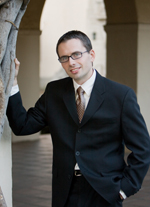 I am an alumnus of the Atwater research group at the California Institute of Technology. I received my Doctor of Philosophy in Electrical Engineering in June 2010. I have established this page to provide information about my work as a graduate student.
I am an alumnus of the Atwater research group at the California Institute of Technology. I received my Doctor of Philosophy in Electrical Engineering in June 2010. I have established this page to provide information about my work as a graduate student.
My research at Caltech focused on developing low-cost solar cells made from silicon microwires. I studied the growth of silicon microwire arrays, the formation of radial p-n junctions, and the fabrication of novel light-trapping microstructures. Over the years I enjoyed numerous opportunities to design and build new instrumentation for the lab, enabling us to characterize the material quality, optical absorption, and photovoltaic performance of these solar cells. I also became interested in numerical simulation techniques, and developed an optoelectronic model to simulate and optimize the behavior of silicon microwire solar cells. These efforts reflect the tremendous support of my advisor, Prof. Harry Atwater, as well as a close collaboration with Prof. Nathan Lewis, and the exceptional talent of my numerous colleagues in both research groups.
-
The more-affordable photovoltaic solar cell
Silicon microwire-array solar cells receive a 2010 Popular Mechanics Breakthrough Award.
-
Photovoltaics: More solar cells for less
Zia Zhu and Prof. Yi Cui (of Stanford University) discuss our study on the optical absorption of silicon wire arrays in a News and Views article in the March 2010 issue of Nature Materials. This work is also highlighted by MIT Technology Review.
-
Photocathode materials: Array of sunshine
Work on silicon microwire-array photocathodes is highlighted in the January 2010 issue of Nature Chemistry.
-
Chemistry: The photon trap
Nature News highlights the development of silicon microwire-arrays for solar fuel sources.
-
Students go solar
The Caltech Student Solar Initiative leads the installation of a 14 kW solar array on the rooftop of our laboratory, as highlighted by this article from Caltech's Engineering and Science magazine (Winter 2008).
